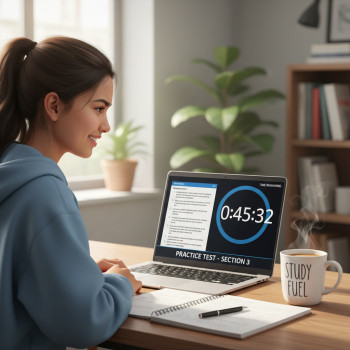Why high SAT scores still matter — especially for financial aid
Talk to any student or parent navigating the college admissions maze and you’ll hear a familiar refrain: grades, activities, essays — they all matter. But one often overlooked lever that can have immediate, measurable impact on college affordability is the SAT. Even in an era when many colleges have adopted test-optional policies, high Digital SAT scores remain a powerful bargaining chip for merit-based scholarships and institutional aid. The reason is simple: colleges have limited pools of money to attract top academic talent, and measurable, comparable test scores are an efficient way to identify — and reward — that talent.

How colleges convert high SAT scores into financial aid
Colleges typically use two broad approaches when awarding aid tied to test performance:
- Automatic merit scholarships: These are awards triggered by meeting a specific SAT (or GPA) threshold. If your Digital SAT score hits the published marker, you automatically qualify for a stated scholarship amount.
- Competitive institutional awards: These are selective scholarships where SAT scores weigh heavily alongside GPA, essays, and extracurricular leadership. High test scores elevate your competitiveness in these pools.
Combine those with state-level or private merit awards and you can reduce sticker price dramatically. For many families, this shifts a college from “possible but unaffordable” to “definitely doable.”
Real-world example
Imagine two applicants to the same university — Sara and Malik. Both have similar GPAs and extracurriculars. Sara earns a Digital SAT score in the top 5% nationally; Malik’s score is a few hundred points lower. Even if both are admitted, Sara’s high score can trigger a four-year merit scholarship or place her in a small pool for a prestigious fellowship — changing net costs by tens of thousands of dollars over four years.
Which colleges are known for generous merit aid tied to SATs?
While policies change each year, there are identifiable patterns: private universities with sizable endowments and public flagship/state honors programs are often the most generous with merit aid tied to strong test performance. Many state scholarship programs also explicitly cite SAT thresholds as eligibility criteria.
Keep in mind: institutional generosity isn’t only about sticker price — it’s also about predictability. Automatic scholarships tied to scores are easier to plan around, while competitive awards can vary by year.
Categories of schools to consider
- Private universities with endowment-backed scholarships: These schools can create multi-year merit packages to attract high-scoring students.
- Public flagships and honors colleges: State universities often have honors programs that bundle tuition discounts, stipends, or guaranteed scholarships for top SAT performers.
- State merit programs: State governments sometimes operate scholarship programs with explicit SAT cutoffs.
How much money are we actually talking about?
Scholarship amounts vary widely. To give a concrete sense, here’s a representative table that illustrates typical award ranges you might see tied to high SAT scores. These figures are illustrative ranges based on common institutional and state practices; check specific college pages for exact numbers during application season.
| Type of Award | Typical SAT Threshold (approx.) | Typical Award Range (per year) | Duration |
|---|---|---|---|
| Automatic institutional merit | Top 5–15% (varies by school) | $5,000–$25,000 | 1–4 years (renewable) |
| Competitive endowed scholarship | Top 1–5% | $15,000–$40,000+ | 1–4 years, often renewable |
| State merit scholarship | Often explicit cutoffs (e.g., 1300–1400+) | $2,500–$10,000 | 1–4 years, often renewable |
| Honors college packages | High SAT within state’s top percentiles | Reduced tuition, stipends, or $5,000–$20,000 | 4 years |
Timing and strategy: when to focus on raising your Digital SAT score
Timing matters. Here’s a pragmatic timeline that many students use:
- Freshman–sophomore years: Build foundation: rigorous coursework, reading widely, and practicing core math concepts. Early exposure reduces late-stage cramming.
- Junior year (first semester): Take a proctored practice test to set a baseline and target score ranges for desired scholarships.
- Junior year (spring): Aim to take the Digital SAT at least once. Many students take it multiple times; the College Board’s digital format has faster reporting, making retakes viable before early application deadlines.
- Senior year (fall): If necessary, retake early enough to meet scholarship application deadlines; use targeted review to close specific gaps.
Why early testing helps
Most merit deadlines align with early application cycles. By testing early, you can:
- See where you stand for automatic scholarships.
- Plan targeted retakes.
- Include strong scores in early application materials.
Study smarter: evidence-based approaches to boost Digital SAT performance
Preparing for the Digital SAT is not about grinding hours mindlessly; it’s about focused practice on high-leverage skills. Here are strategies that consistently move the score needle:
- Diagnostic-first approach: Start with a full-length digital practice test to identify weak areas. Use results to prioritize study topics.
- Deliberate practice: Work on specific question types you miss repeatedly rather than redoing whole tests.
- Timed practice: The digital test has different pacing and navigation — practice under time pressure to build rhythm.
- Review errors deeply: For every mistake, write why the error happened and what to do next time.
- Mix content and strategy: Content knowledge (algebra, grammar rules) and tactical skills (passage mapping, answer elimination) both matter.
How personalized tutoring accelerates gains
One-on-one tutoring can be a game-changer because it targets your unique gaps and keeps you accountable. Personalized tutors help students with tailored study plans, focused strategies for question types, and realistic practice schedules. For students who want a structured, efficient path to a higher score, Sparkl’s personalized tutoring offers 1-on-1 guidance, tailored study plans, expert tutors, and AI-driven insights that highlight the exact concepts to prioritize — helping families maximize scholarship potential while minimizing wasted time.
Balancing test prep with applications and financial aid paperwork
Families often race against multiple deadlines: test dates, scholarship cutoffs, admissions deadlines, and the FAFSA opening. Practical planning keeps you ahead:
- Create a master calendar with test dates and each college’s scholarship deadlines.
- Complete the FAFSA (Free Application for Federal Student Aid) as soon as it opens; some institutional awards consider FAFSA completion.
- Prepare scholarship essays early — for competitive awards, a polished personal statement matters as much as scores.
- For automatic awards, confirm whether the college uses the highest single test, superscoring, or the most recent score.
Common myths about SATs and financial aid — busted
There’s a lot of misinformation out there. Let’s clear up the most damaging myths:
- Myth: “Test-optional schools don’t give merit aid based on scores.” Reality: Many test-optional schools still grant scholarships to applicants who submit strong scores.
- Myth: “Only Ivies give big money for test scores.” Reality: Numerous private universities and public flagships offer significant merit awards tied to high scores — sometimes more predictably than top-tier selective schools.
- Myth: “One high test date doesn’t matter if the rest of my application is average.” Reality: For automatic merit awards, a qualifying test score can literally trigger a scholarship regardless of other components, though competitive awards do consider the whole application.
Putting it all together: a sample 6-month action plan
Here’s a focused plan that students with limited time can follow to push their Digital SAT score and position themselves for merit aid.
- Month 1 — Diagnostic & plan:
- Take a full-length digital practice test.
- Create a targeted study plan — aim for specific score gains per section.
- Identify scholarship targets and their score thresholds.
- Month 2–3 — Skill building:
- Work 6–10 hours/week on content and question-type drills.
- Weekly timed practice sections and review sessions.
- Month 4 — Test simulation & refinement:
- Take two full digital practice tests under test-like conditions.
- Refine timing and strategy; focus review on persistent error patterns.
- Month 5 — First official test:
- Take the Digital SAT.
- Immediately review results and compare to scholarship thresholds.
- Month 6 — Retake if needed & finalize applications:
- If necessary, do a focused 4–6 week review and retake before scholarship deadlines.
- Finalize FAFSA, scholarship essays, and application materials.
Where tutoring fits into this plan
Personalized tutoring can be slotted at any stage. For many students, adding a tutor during Month 2–3 accelerates mastery; for students who already have strong fundamentals, a tutor in Month 4–5 helps iron out test strategies and calm test-day nerves. Sparkl’s model — mixing expert tutors with AI-driven insights and tailored plans — is designed to be flexible so it fits into a student’s calendar without overwhelming other priorities.
How to research and verify a college’s scholarship policy
Don’t assume: verify. When evaluating a college’s potential for SAT-based aid, look for these specifics on the school’s financial aid or admissions site:
- Does the school list automatic merit scholarship thresholds and amounts?
- Does the school superscore the SAT (combine section scores from multiple test dates) or use the highest single test?
- Are merit scholarships need-aware or need-blind? (This affects how test scores interact with demonstrated financial need.)
- What deadlines apply for scholarship consideration — are they earlier than the regular admission deadline?
Always keep a screenshot or PDF of the policy page and the date you accessed it — financial-aid pages change, and having a record helps in later discussions with admissions or financial-aid offices.
Negotiating offers and maximizing aid
If you receive multiple offers, including merit packages, you’re in a strong position. Colleges sometimes adjust offers if presented with a better package from another institution. Tactful, evidence-based conversations with financial aid offices can yield additional funds:
- Collect written offers from other schools.
- Prepare a concise summary of your financial situation and why increased aid matters.
- Reach out to the financial aid office with a polite request for reconsideration.
Keep expectations realistic, but remember: advocacy works. Many families successfully secure additional institutional funds through this process.
Beyond scores: complementary ways to strengthen scholarship candidacy
High SAT scores open doors — but combining them with other strengths multiplies opportunity. Consider these complementary moves:
- Build a clear story in essays that aligns with the college’s values.
- Highlight leadership, community service, or research experiences in applications.
- Apply for state-level scholarships that explicitly list SAT thresholds.
- Consider honors colleges within public universities — they often bundle special aid with enriched academic opportunities.
Final checklist before you hit submit
Make sure you’ve covered the essentials so your test performance translates into financial benefit:
- Have you confirmed each target college’s scholarship thresholds and deadlines?
- Did you submit scores in time for automatic consideration?
- Is your FAFSA completed and submitted? (This can be required for institutional awards.)
- Have you completed any scholarship-specific essays or applications?
- Do you have a backup plan in case you fall short of an automatic cutoff — e.g., competitive scholarships, other schools with generous offers?

Parting advice: play the long game
College affordability is rarely decided by one factor. High Digital SAT scores can unlock significant merit aid, but the biggest wins come from a coordinated strategy: early testing, targeted preparation, timely FAFSA completion, and careful research into each school’s policies. Keep perspective — a high test score is a major asset, but it’s most powerful when combined with a thoughtful college list and polished application materials.
If you’re wondering where to begin: start with one timed practice test, make a short plan, and iterate. If you want more structure, consider personalized 1-on-1 guidance: tutors who help you focus on the lessons that give you the biggest returns and an evidence-based schedule to fit around school and activities. Sparkl’s personalized tutoring is a resource many families find helpful because it offers tailored study plans, expert tutors, and AI-driven insights that point to exactly what to improve — helping students convert strong scores into substantial scholarship dollars.
Summary: a roadmap to turning SATs into scholarship money
Here are the essential takeaways to keep close:
- High Digital SAT scores remain a direct path to both automatic and competitive merit awards.
- Start with a diagnostic, build a focused study plan, and test early enough to meet scholarship deadlines.
- Research each college’s exact policy on score use, superscoring, and scholarship thresholds; document what you find.
- Complete the FAFSA early — many institutional awards require or consider it.
- Use personalized tutoring if you want to maximize efficiency — a targeted coach can help convert study hours into score gains and net-cost savings.
With a thoughtful approach, a few targeted months of preparation can change the financial equation for four years of college. Treat your Digital SAT strategy as part of a broader scholarship plan, and you may find your dream school becomes significantly more affordable than you imagined.
Ready to take the next step?
Begin with one realistic, timed practice—then plan the next 6 months. If you’d like a guided, efficient plan that focuses on the exact concepts and question types that will raise your score, consider reaching out for personalized tutoring. Small, focused changes now can produce big savings later.





















No Comments
Leave a comment Cancel